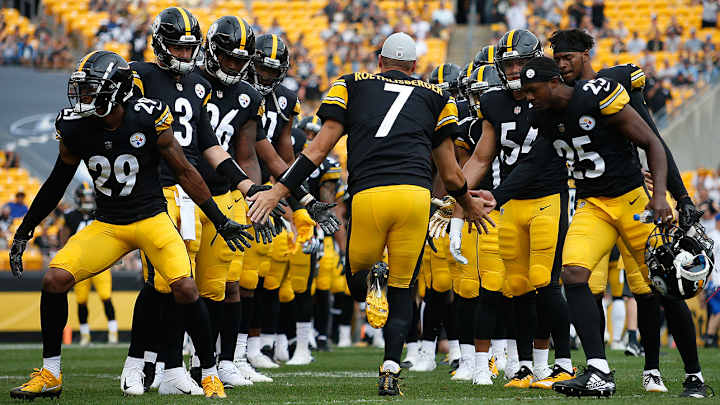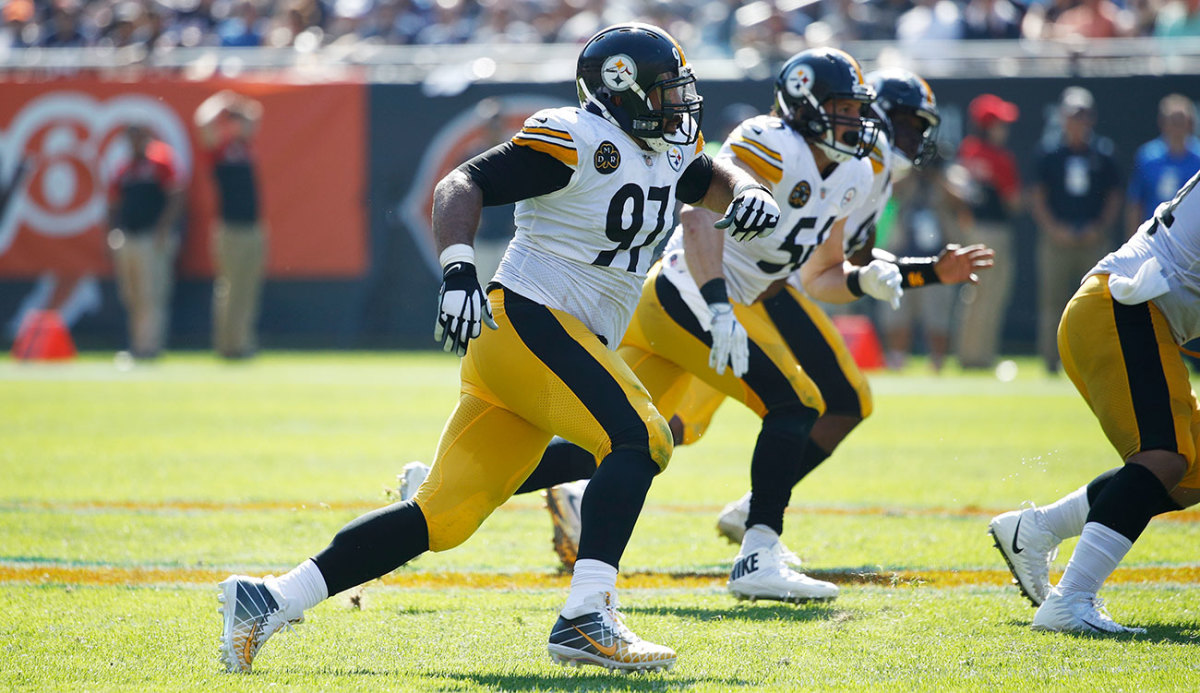Replacing 50 Isn’t Easy: 10 Thoughts on the 2018 Steelers

As the NFL season approaches, Andy Benoit is previewing every NFL team in reverse order of last season’s finish. Up today: the Pittsburgh Steelers, who went 13–3 last year and lost to the Jaguars in the divisional round.
1. Before Ryan Shazier went down early in Week 13, the Steelers had one of the NFL’s most dynamic defenses. Its scheme was multifaceted yet crisply defined: On running downs coordinator Keith Butler employed both 4-3 and 3-4 looks with traditional zone coverage. On passing downs he had unique blitzes, often starring breakout corner Mike Hilton from the slot and power linebacker Vince Williams inside. Butler brought these pressures out of two-deep zone coverage, which is almost antithetical to the single-high man coverage most teams play behind blitzes.
But Shazier’s absence left a giant hole that Williams couldn’t fill in passing situations and backups L.J. Fort and Tyler Matakevich couldn’t fill in any situations. From Week 13 on, the Steelers allowed 37.5 more rushing yards per game and a full yard more per pass attempt (a huge increase). In the divisional round loss to the Jaguars, Jacksonville feasted on those fill-in linebackers.
And so the Steelers entered this offseason with that one glaring linebacker weakness standing between them and a Super Bowl-caliber defense (opposite their lethal offense, no less) They had no other urgent needs to address, and this draft boasted four first-round inside linebackers. And yet GM Kevin Colbert, true to the organization’s history, did not trade up from Pick 28. Instead he watched all four linebackers fall off the board and tapped (reached for?) Virginia Tech safety Terrell Edmunds.
For the Steelers, A Retooled Secondary Is Job No. 1
It appears Pittsburgh plans to join the growing number of defenses that play primarily with three safeties. To do this, either Edmunds will move to stack linebacker, or free-agent pickup Morgan Burnett, who learned to this role with the Packers in 2016, will take on the responsibility. This is assuming Edmunds, whom some viewed as a mid-round talent, can promptly learn the complex scheme. This three-safety experiment will determine the Steelers’ fate in 2018.
2. The Steelers have a trove of blitzes, but Butler dials them up selectively. According to Football Outsiders, he rushed five or more only 22.5 percent of the time last year—19th in the NFL. Thirty-nine of Pittsburgh’s NFL-leading 56 sacks actually came on some sort of four-man rush. This D-line can generate its own pressure. Stephon Tuitt and Javon Hargrave are strong, 300-plus pounders who move like 260-pounders. And then there’s eighth-year veteran Cameron Heyward, whose near-perfect technique magnifies his already outstanding power and quickness.

3. Second-year pro T.J. Watt is also a big facet of the four-man rush. Don’t let his vacillating rookie year production fool you. Watt has desirable twitch and a sense for using his hands. He’s also a proficient zone-coverage dropper, which is significant in a scheme that dropped eight defenders into coverage on 16.6 percent of its snaps last year (third most in the NFL, behind New England and Kansas City). One indicator that Watt will drop is if he’s aligned over the guard, in a standup joker position.
4. Many Steelers fans think third-year safety Sean Davis has not developed. The film disagrees. Yes, Davis has had some valleys. (Remember Rob Gronkowski torching him at the end of New England’s narrow victory in Pittsburgh last December?) But more often, you see the talent that got the lithe 202-pounder drafted in the second round. All along, Steelers coaches have believed Davis, who has played strong safety and slot corner, could become a premier free safety. With Mike Mitchell gone and new safeties Edmunds and Burnett more comfortable near the line of scrimmage, Davis will get a crack at patrolling centerfield in 2018.
• 2018 TEAM PREVIEWS: Andy Benoit’s 10 thoughts on each team as the season approaches
5. The other maligned defensive back is Artie Burns, who came in the same year as Davis, only as a first-round pick. Burns is more of a matchup-style corner and has had ups and downs adjusting to some of Pittsburgh’s zone principles. Longtime Brown Joe Haden’s 2017 arrival suggested the Steelers were serious about playing more man coverage, though we didn’t really see that other than the game against New England. It’d behoove Butler and Mike Tomlin to implement more man coverage for their perimeter corners. That can be done without altering too many of their zone structures.
6. Because we’ve long been so enamored with how he sheds would-be sackers and extends plays, we overlook what an incredible pure thrower Ben Roethlisberger is. His precision accuracy is amongst the best of all time—and that includes when he’s under duress. That accuracy is a big reason why Antonio Brown makes so many tough catches against dedicated double-teams (especially in two-minute situations).

7. The other overlooked part of Roethlisberger is his high pre-snap IQ. This allows him to make checks at the line of scrimmage, giving the Steelers a potent quick-strike passing game out of spread formations. Two notes from those spread formations: They often feature Brown and Le’Veon Bell on the weak side together, and defenses must be on high alert for wheel routes by the slot receivers.
8. Bell is only 26, but with a lot of mileage. He’s had mild off-field issues and some notable injuries, and he didn’t produce a single run over 30 yards last year. It’s understandable for GM Kevin Colbert to franchise-tag him again rather than commit long-term. That option may not be feasible in 2019, which makes 2018 a make-or-break year for this tailback-team marriage. Bell is still the best in the NFL at his position. His patient running creates a down-to-down sustainability, with four-plus-yard runs common and negative runs rare. He’s also a lethal pass-catcher, both on checkdowns (which naturally get him the ball in space) and receiver-type routes. That versatility, coupled with Roethlisberger’s ability to check in and out of plays, makes the Steelers nearly impossible to match up against.
Le’Veon Bell Is Right, and So Are the Steelers
9. Pittsburgh’s rushing scheme brilliantly capitalizes on Bell’s unique patience. Right guard David DeCastro and center Maurkice Pouncey are the most mobile interior blocking tandem in football, save for maybe (and only maybe) Dallas’s Zack Martin and Travis Frederick. Pittsburgh features their mobility on sweeps and pull-blocking runs like “power” and especially “counter”—slower-developing plays that give Bell time to read the D. On inside runs you almost always see double-team blocks. Bell’s patience shines here the most; the longer the run takes, the longer the double-teams can last. The laws of physics dictate that eventually those double-teams, with 600 pounds of offensive players pushing a 300-pound defender, will win.
10. Second-year receiver JuJu Smith-Schuster has a chance to be special. He might not have the electrifying athleticism to be the focal point of a scheme, but he’s thick and tough enough to win on inside routes in a traditional run-intensive scheme, and just quick and fast enough to be productive in spread designs. With good players around him, Smith-Schuster can be a perennial 1,200-yard guy.
Question or comment? Email us at talkback@themmqb.com.
